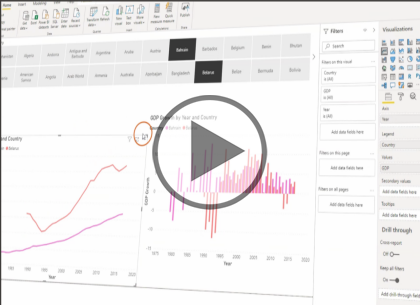Course description
Data Science is a growing field, this second course in the series digs into the Query Editor and Advanced Transformations.
Data Analysts are responsible for designing and building scalable data models, cleaning and transforming data, and enabling advanced analytic capabilities that provide meaningful business value through easy-to-comprehend data visualizations. The PL-300 Exam validates this expertise.
Prerequisites
Experience with Microsoft Excel, pivot tables and power pivot modelling is helpful.
Meet the expert
Nikolai is a mathematician and works as a data scientist in a large German company. He is focused mainly on gaining insights from data and creating a positive impact with this knowledge.
Course outline
Query Editor Module 1
Connecting to our Data Source (30:39)
- Introduction (00:13)
- Connecting to our data source_new (06:48)
- Editing and removing rows (08:10)
- Changing data types (08:24)
- Replace Values (03:27)
- Close & Apply (03:29)
- Summary (00:08)
Connecting Power BI to a CSV File (24:21)
- Introduction (00:08)
- Connecting Power BI to a csv file (03:21)
- Connecting to a Web Page (05:04)
- Extract Characters (06:18)
- Splitting & Merging Columns (09:22)
- Summary (00:08)
Create a Conditional Column (32:09)
- Introduction (00:08)
- Create a conditional column (05:52)
- Columns from examples (08:38)
- Merging Queries (04:00)
- Joins (06:35)
- Apply the Knowledge (06:47)
- Summary (00:08)
Query Editor Module 2
Pivoting & Unpivoting (28:54)
- Introduction (00:13)
- Pivoting & Unpivoting (05:43)
- Appending Tables (08:20)
- Practice & Solution PopulationTable (14:30)
- Summary (00:08)
Fact Dimension Model (21:05)
- Introduction (00:08)
- Fact Dimension Model (09:19)
- Practice Load Dimension Table (03:48)
- Organizing our Queries in Groups (02:59)
- Entering data manually (04:43)
- Summary (00:08)
Creating an Index Column (25:53)
- Introduction (00:08)
- Creating an index column (03:04)
- Workflow & more transformations (04:38)
- Module Summary (05:05)
- Excersice 1 Instructions (01:41)
- Exercise 1 Solution (11:09)
- Summary (00:08)
Advanced Transformation
Advanced Editor - Best Practices (23:25)
- Introduction (00:13)
- Advanced Editor - Best practise (08:43)
- References vs. Duplicates (09:50)
- Enable Disable Load & Report Refresh (04:31)
- Summary (00:08)
Group by (24:33)
- Introduction (00:08)
- Group by (04:47)
- Mathematcal Operations (04:54)
- Run R Script (14:36)
- Summary (00:08)
Using Parameters to Transform Data (12:10)
- Introduction (00:08)
- Using Parameters to transform data (06:28)
- Exercise 2 Instructions (00:55)
- Exercise 2 solution (04:31)
- Summary (00:08)
Understanding Relationships (17:28)
- Introduction (00:08)
- Understanding relationships (05:07)
- Create & Edit relationships (06:16)
- One-to-Many and One-to-One Relationship (05:49)
- Summary (00:08)
Many-to-Many Relationship & Crossfilter Direction (14:27)
- Introduction (00:08)
- Many-to-Many relationship & Crossfilter (08:15)
- Cross filter direction (05:56)
- Summary (00:08)
Activate and Deactivate Relationships (13:16)
- Introduction (00:08)
- ActivateDeactivate Relationships (05:52)
- Create Model Summary (03:04)
- Exercise 3 - Create Model (02:27)
- Exersice 3 - Solution (01:37)
- Summary (00:08)



